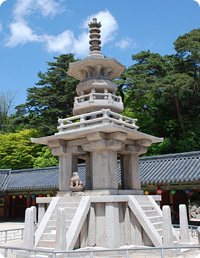WINTER OLYMPICS
Post-Olympics 10 days
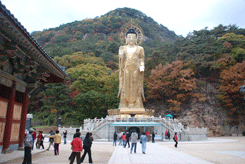
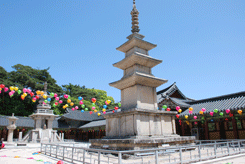
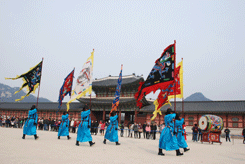
Click on the days to access the programs quick
| Days | Visits and Activities | Distance |
| Day 1 | Pyeongchang - Punggi - Andong | 240km |
| Day 2 | Andong - Songnisan | 140km |
| Day 3 | Songnisan - Gongju - Buyeo | 160km |
| Day 4 | Buyeo - Jeonju - Namwon - Gurye - Suncheon | 260km |
| Day 5 | Suncheon - Tongyeong - Geoje - Busan | 210km |
| Day 6 | Busan - Yangsan - Gyeongju | 120km |
| Day 7 | Gyeongju | |
| Day 8 | Gyeongju - Seoul | 430km |
| Day 9 | Seoul | |
| Day 10 | Departure | 60km |
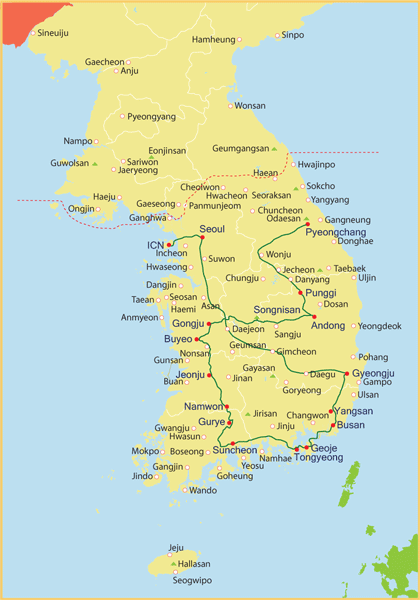 Day 1 Pyeongchang - Punggi - Andong (- - -) 240km
Day 1 Pyeongchang - Punggi - Andong (- - -) 240km
With leisurely time to pack, travel to Andong, a stronghold of Confucianism that has deeply influenced the lives of Koreans in all aspects. En route, you will visit Korea's first private school, Sosuseowon. It was a birthplace of Confucian education and a cradle of prominent scholars. It was established by Ju Se-bung in 1543 and named Baekundong Seowon. The compound itself is composed of two sections; academic studies and research, and memorial service. There are several old buildings where scholars learned and studied loyalty, filial piety, manners and knowledge. The institute has a Shrine, which was built to enshrine An Hyang, An Bo, An Chuk and Je Se-bung, where a memorial service takes place twice a year on the first day of the third and ninth months by the lunar calendar.
While in Punggi, experience ginseng market. There are small stalls in the building type market, all of which has piles of fresh ginseng roots, ginseng preserved in wine in fancy bottles, dried ginseng, tea, extract, candy, and honey ginseng slices. This mysterious root, which has a good smell better than it tastes, has historically been considered an empowering medicine and a cure-all; effective in recovering the liver's functions, improving anticancer and immunity functions, and treating diabetes, hypertension, low blood pressure and stress. Ginseng also facilitates recovery from fatigue and the activation of nervous cells. There are also many shops along the street leading out from the painfully quiet train station. Street vendors sell flowers, fruits, food stuff and home grown grains and vegetables. All these features mixed offer a rural ambience of Korea's remote town.
You will explore UNESCO World Heritage Site, Hahoemaeul from the 15th century. It is the best preserved traditional village portraying and spanning the life of the Joseon Dynasty (1392-1910) and some 480 Korean traditional houses, both large and small, are still fully functioning.
As you take a walk in the narrow alleys, enjoy the rustic and old charm of this unique village. You cannot possibly miss a 600-years old zelkova tree, the home to the village spirit. At the tree's base is where residents still make their wishes. The village is also known for traditional festival, Hahoe Mask Dance which gave common people the opportunity to mock those in authority, and in particular the Byeolsingut, a shaman ritual exorcising evil spirits, dating back to the Goryeo dynasty (918-1392).
Day 2 Andong - Songnisan (B) 140km
Visit Andong Folk Museum for anin-depth information of traditional life and illustrating traditional Confucian culture. The museum exhibits a variety of legacies relating mainly to four cardinal ceremonies, coming of an age, wedding, funeral, ancestral memorial service, as well as dozens of pieces of pottery, utensils, clothing, farming tools and traditional folk games in small models.
Travel to Songnisan national park, weaving through the countryside with its rural vistas. The Songni literally means an "escape from vulgar". The tour passes through Maltijae, a 12 hairpin turn, and shortly thereafter stands a 600-year-old pine tree. Shaped like an open umbrella, it is 15 meters high with a girth of 4.5 meters. This tree was granted a ministerial title when it reportedly lifted its branches in order to let king's palanquin pass in the mid 15th century. In recent years several branches were damaged by wind and snow, though what remains is still beautiful.
Explore Beopjusa temple dating back to AD 553. The temple boasts of three national treasures and numerous cultural assets. Palsangjeon that houses eight paintings of different stages of the Buddha's life is the five story wooden pagoda constructed in early 17th century, and is a very rare and unique Buddhist architectural structure. Gazing down at the Palsangjeon is a 33m high and 160 ton Maitreya Buddha, the Buddha of the Future. The giant iron pot whose diameter is 2.7 meters that may well had been used to feed 3,000 priests in the early 12th century is on display in the temple courtyard. A stone carved lantern supported by twin lions standing face to face is a rare example of the magnificent Silla sculptures. A stone water cistern shaped like an open lotus flower is considered unique for beauty and design. This stone lotus blossom from the 8th century is supported by a round short stone carved like a mushroom. Nearby are two stone pillars which once held the temple banner pole. An excellent carved relief called Maaebul also can be seen.
The temple holds Four Buddhist Instrument
Ceremony at sunset. The bell, which almost all Korean temples are equipped with, is one of the four Dharma instruments together with Dharma drum, wooden fish, and cloud-shaped gong. Hearing it reverberating through the universe, you will reflect upon the profound symbolism of the instruments. It is a great vow to save, or enlighten, the creatures in the universe including those on land, in the sea, in the air and in hell.
Day 3 Songnisan - Gongju - Buyeo (B) 160km
Gongju is a charming city that once served as the Baekje's capital for 63 years from 475 to 538. Today, you will explore archaeological sites and ancient historic areas, which were collectively named as a UNESCO World Heritage sites. Visit Gongju National Museum and get a glimpse of the fascinating archaeological articles from Baekje (BC18-AD660) era, and artifacts excavated from the royal tomb of King Muryeong (501-524), one of the last rulers to reign in the capital of Gongju.
Near museum is UNESCO World Heritage site of Songsanri Tombs, a group of royal tombs that just look like a cluster of grassy knolls. The tomb which belongs to King Muryeong (462-523) and his wife, the queen was found completely intact since it was sealed in the early 6th century. The actual tomb was permanently closed, but you will see an excellent, albeit miniature duplicate.
Afterwards, drive to the ancient royal city of Buyeo, a melting pot of Baekje culture which is often regarded as the most artistically sophisticated of the Three Kingdoms.
Enjoy a stop at Gungnamji, and stroll along the Korea's oldest artificial pond dating back to 634. Built as a pleasure garden for the royal family, this circular pond ringed by weeping willow trees creates a colorful spectacle with its stock of water lotuses in summer. Added on UNESCO World Heritage List, Jeongrimsa temple site is one of the city's most distinctive and outstanding landmarks. Check out the ruins of the lotus pond, a 5.62m-high Buddha image sitting on a stone pedestal, and a five-storied stone pagoda standing tall remain to recall the glory.
At Buyeo National Museum, you will find the spirit and the essence of the brilliant culture of Baekje and marvel at the beautiful gilt bronze incense burner which measures 11.8Kg and 61.8cm high. The incense burner is categorized by lid, bowl and pedestal stand. The top of the lid is capped with a phoenix, which appears as if it is ready to fly away, is holding a cintamani ball and, on the cover, 42 animals such as the phoenix, tiger, deer, and others are hanging about in the spaces among 74 mountain peaks thinly cast in five layers reaching the top. The lid is also ventilated with 10 holes to release the scent of the incense.
The bowl of the burner is shaped in the form of a blossoming lotus. The petals of the lotus also contain 2 human figures and 27 animals on the lateral surface including fish, heavenly beasts, and birds. Some of the animals rest between the lotus petals, while others are top.
The pedestal stand is in the shape of a dragon surrounded by a blowing bronze motif of clouds with its mouth supporting the base of the bowl, and its own tail is arched, giving the base a sense of movement.
The Gilt-bronze Incense Burner of Baekje and the Five-story Stone Pagoda of Jeongnimsaji are considered the most representative Baekje-era relics. Created over 1,500 years ago, these artifacts show a graceful dignity that is unique to Baekje and preserve the elaborate skills of Baekje craftsmen.
Stroll up paths to the UNESCO World Heritage site of Busosan to explore Baekje fortification. At the foot of the hill stands a small shrine called Samchungsa dedicated to three loyal subjects; Gyebaek, Seongchung and Heungsu. At the top of the hill sits Yeongullu pavilion where the king once came to watch the sun rise over his kingdom.
A little further down the trail, you will see a pavilion called Baekhwajeong perched at the top of the rock. It was built in memory of the women who jumped off the cliff on the last day of kingdom beside which locates Nakhwaam, literally meaning Falling Flower Rock, on a bluff overlooking the Geum River at the bend called Baekma. As enemies swarmed into the capital, the court ladies flung themselves into the water from this bluff rather than suffer the shame of submitting to atrocities of the conquering enemy armies. Below the bluff is a small temple, Goransa, which takes its name from crypsinus hastatus having medicinal properties that grows behind this temple.
Day 4 Buyeo - Jeonju - Namwon - Gurye - Suncheon (B) 260km
Jeonju is a time-honored tradition as well as significant cultural and artistic heritage. You will explore Jeonju Hankok village, a Korean House complex retaining much of their perfection intact. Near the entrance of the complex stands Gyeonggijeon that holds the portrait of founder king of Joseon dynasty, featuring him seated in a magnificent red chair with three gold-foiled dragons on his royal blue robes. And on its front is a beautiful Jeondong Catholic church of Byzantine and Romanesque architectural design. Completed in 1914, it is one of the oldest and largest Western-style buildings in the region. It was designed by master church builder Victor Lousi Poisnel, the Norman priest whose work in Korea includes Myeongdong Cathedral in Seoul. Just west of the church is the stately Pungnammun gate, where three Catholics paid for their religion with martyrdom on December 8, 1791, marking the first time in Korea.
Next, you will stop off at Namwon, a charming city with many historical sites and tourist attractions. It is also famous as the home of Chunhyang, the faithful maiden whose story has been often compared to the Romeo and Juliet. At the center of the town is a park, in which stands Gwanghallu Pavilion where Chunhyang and her lover are said to have first met, and there is a bridge built on a pond that is supposed to ensure connubial bliss to any couple that steps on it.
Namwon is also known for the home of traditional music. Many famous Pansori, Korean opera, singers are from this small town. A visit to the Namwon Classical Music Institute offers an opportunity to enjoy Korean traditional music including vocal and instrumental music. While there in Namwon, you will have a chance to learn Korean Sori.
Then, on to Jeonju, a city of time-honored tradition as well as significant cultural and artistic heritage.
The journey continues to Gurye and visit the 6th century Hwaeomsa. The temple is dedicated to the vairocana Buddha, the cosmic head of the Hwaeom trinity. First, One-Pillar Gate standing at the lower part greets you and leads you up to the second and the third gate - from the secular world into the spiritual world. On the second level, there is the Bojeru, the Save All Beings Hall, beside which stands bell and drum tower and two magnificent 5-story stone pagodas from Silla period. Gakhwangjeon has a double storied roof, and houses seven figures on its altar. Sakyamuni Buddha sits in the middle attended by Amitabha and Prabhytaratna, as well as Avalokitesvara, Samantabhadra, Manjusri, and Ksitigarbha. A magnificent stone lantern and an impressive stone pagoda supported by four fierce looking lions adorn this hall. On the hill behind Gakhwangjeon stands the most uniquely designed three-story stone pagoda supported by four lions each of which represents the four primary human emotions: love, sorrow, anger, and joy. Here, you will enjoy the intricacies of this masterpiece as there are numerous other designs etched onto the pagoda.
You will also tour Nagan Fortress Village that is surrounded by 1,410-meter long fortress which was built into a mud rampart in the 14th century to repel Japanese pirate raids. The village features nearly 90 traditional thatched roof houses which are still fully functioning and a peculiar townscape in harmony with the rectangular stone rampart. One unusual aspect of the town is that it was inhabited by a number of different clans rather than having one dominant one. Part of the fortress wall arches over the hill and you will today take in a great view of the entire village. Strolling around the small alleyways within the village, you will get a better sense of the traditional housings, cultural landscape, timeold customs and rituals representing the agricultural society of Korea.
Day 5 Suncheon - Tongyeong - Geoje - Busan (B) 210km
The southern boundary of Korea is a sunken coastline which has created an irregular pattern of bays and inlets.
Tongyeong is a traditional seaport of great charm and historical interests. Tour the Dongpirang village where you will enjoy witty and delightful murals and sweeping view of Tongyeong harbor. This village was on the verge of being torn down, but what were once shabby houses now welcome visitors with radiant colors.
On a long stretch of quay-side is Jungang market, and you will witness a lively atmosphere as vendors try to make a deal. Rows of seafood restaurants and local eateries offer anything that comes from the ocean, the sights, sounds and smells of a fishing port. At the nearby Gangguan port, you may want to step in to the replica turtle ship from the 16th century. Later, you will visit Lacquerware Museum and marvel at the sophisticated craftsmanship and nacre Lacquerwares that have long been admired and sought after by collectors and aficionados worldwide.
Geoje is a shipbuilding Mecca featuring several natural harbors. And once was the final port of call of the SS Meredith Victory at Christmas 1950. It is best known for evacuating more than 14,000 refugees in a single mission in the largest humanitarian rescue operation by a single ship during the Korean War.
There’s time to visit the POW Camp which at one time held around 170,000 prisoners in 28 facilities until an armistice was concluded in 1953. The former camp has been reborn as a historic park with various exhibition halls that help visitors comprehend the actual situation at the time and gives visitors an up close lesson on the devastating consequences of the war. POW camp accommodated 150,000 North Korean soldiers and 20,000 Chinese soldiers.
From August 5 to September 6, 1953, under the name Operation Big Switch and Operation Big Swap, both side prisoners were repatriated, at their free choice of destination, at Panmunjeom. The U.N.C. returned 75,823 POWs (70,183 Koreans, 5,640 Chinese); the Communists repatriated 12,773 U.N.C. POWs (7,862 Koreans, 3,597 Americans, 946 British). The vast majority of the 22,600 enemy non-repatriates were Chinese, most of them former Chinese Nationalist veterans. Only 137 Chinese agreed to return to their homeland before the expiration of the ninety-day period stipulated in the armistice agreement. Only 357 U.N.C. prisoners indicated a desire to remain with the Communists (333 Koreans, 23 Americans, one Briton), and of these, two Americans and eight Koreans chose to return within the allotted time for the changing of one's mind. The U.N.C. released all remaining former POWs thereafter, the Communists following suit in a few days later.
Today, you will experience the deepest highway on earth, Geoga bridge, a 8.2km-long bridge which is a combination of two cable-stayed bridges built on the open sea, a number of approach bridges and tunnels built on three islands in the middle and a 3.7km-long immersed tube constructed 48m below mean water level.
Busan is Korea's second largest city surrounded by the ocean on one side, and mountains on the other. Its deep harbor and gentle tides have allowed it to grow into the largest port in Korea and the fifth largest in the world. It is also a center of industry and commerce, a thriving metropolis formed unusually long in shape along its coastal line.
Day 6 Busan - Yangsan - Gyeongju (B) 120km
You will tour Yongdusan Park where people of all ages gather for recreational activities. Sitting on top of the hillock of a steep slope is Busan tower topped by an observatory, overlooking the hilly terrain of this mountainous coastal city and the harbor in a breathtaking view. At the smack dab in the middle of the park stands the statue of Yi Sunsin, who is credited with the perfection of the first iron-clad warship in history. You will also see a flower clock and a Busan citizen's bell that they ring on New Years' Day, March 1 and August 15.
Just off the park is Gwangbokro Street, full of shops selling everything from bargains to luxury items. Adjacent is a maze of small streets alive with color, sidewalks sprinkled with unique shops and local eateries. Enjoy the vibrant ambience as you leisurely make your way to the BIFF square, Busan’s modern movie district having hand prints of the famous movie stars and directors on the sidewalk, movie theaters, trendy shops and street food stalls. The area with originally little more than a pair of cinemas that were built over half a century ago had turned into the newly transformed district, and was named BIFF Square on August 14, 1996.
Across the street from the square is a fascinating Jagalchi fish market, a great attraction located dockside. Here you will find a diverse array of seafood on display as you walk along the narrow alleys of street vendors. A nearby indoor market features live fish in the tanks and the upstairs are dried fish along with many restaurants selling raw fish at reasonable prices. The market is really a visual and culinary treat.
En route, stop at Tongdosa temple, literally meaning 'pass through to enlightenment'. The approach to the temple is completely entrancing. Magnificently set by a lane of pine trees dancing in the wind and beside which a mountain stream sings a babbling song, a distinctive and exalting place. Tongdosa was founded in AD 646 and is comprised of 35 buildings. The main hall is unique in that it does not contain a statue of the Buddha, but rather a window looking out onto the Diamond Precepts Altar. This altar leads up to a platform with a bell-shaped stupa that contains the cremated remains of the Buddha himself, thus earning a name the Temple of the Buddha.
Gyeongju is an ancient capital of Silla (BC57-AD935) often dubbed as Museum without Walls. Today, you are treated to one of the ten most historically significant sites in the world with ancient temples, weathered stone pagodas, royal tombs, Buddhist bas-reliefs, and fortress ruins.
Day 7 Gyeongju (B)
With a full day to explore the delights of UNESCO World Heritage Site, Seokguram grotto. It is the home of the serene stone Buddha of the eighth century. Inside, a white statue of a seated Buddha in a sublime state of enlightenment, is surrounded by 37 relief figures of Bodhisattvas, disciples, devas, and guardian kings. The grotto represents the magnificent harmony of religion, science and the arts of Buddhism, symbolizing the pure land in which Buddha resides.
A short ride leads you to another UNESCO World Heritage Site, Bulguksa temple, where you will witness the impressive gates, symbolic bridges leading up to the world of Buddha, graceful architectures, Three-storied Seokgatap and highly ornate Dabotap blending well into the architectural harmony.
At Gwaneumjeon hall, check out the image of the Avalokitesvara who is referred to as the Bodhisattva of Compassion and has a thousand hands, and eyes in each so as to reach out to those in need of help. You will see a gilded statue of Vairocana with the gesture of the first wisdom, Sakyamuni Buddha along with sixteen figures of Buddha's disciples sitting in deep meditation, and a gilt-bronze Amitabha Buddha who is the ruler of the Western Paradise Sukhavati. The architectural design of Bulguksa is one of constrained dignity, peace, and harmony and the temple still remains one of the most remarkable achievements of the ancient Far East.
Visit Gyeongju National Museum for a great insight into Silla culture and history. The first thing that you will notice is The Bell of King Seongdeok, the largest extant bell in Korea. You must certainly stand in awe before the bell from the 8th century with such artistic beauty of design. The bell is distinguished not only for its outstanding beauty but also for its long reverberating sound, the incredibly precise casting technique, in addition to the sad legend surrounding it. On entering the museum, you will marvel at the priceless archaeological and historical artifacts including splendid gold crowns, earrings, belts, ornaments, glassware, potteries, and clay figures as well as a royal barge.
Continue your historic discovery by exploring Donggung palace and Wolji pond, a pleasure garden built to commemorate the victory of Silla. A short walking tour leads you to the ruins of Banwolseong fortress, the world's oldest existing astronomical observatory, Cheomseongdae and finally Tumuli Park that encompasses 23 huge burial mounds. You can go inside Cheonmachong and see how the tombs were made and replicas of the treasures excavated in 1973.
Tour also includes Bunhwangsa temple with 10m-high three-storied rectangular pagoda, the main worship hall with Buddha of Medicine, and legendary well that is said to have saved the kingdom. The nearby open field was once occupied by Silla's largest temple Hwangyongsa. The 67m tall nine-storied pagoda made entirely of wood stood here until it was destroyed during the Mongol invasion in 1238.
Day 8 Gyeongju - Seoul (B) 430km
With leisurely time to pack, excursion to the UNESCO World Heritage site of Yangdongmaeul, a traditional clan village which embraces simple, unadorned natural beauty. Sheltered by forested mountains and facing calm rivers and open fields, the rustic tile and thatch-roofed homes of this village are in perfect harmony with the natural topography. During the Joseon dynasty (1392-1910), this village housed mostly middle upper-class families and contained over 150 homes as well as two shrines. These homes and shrines were built according to the harmonious theory of Yin and Yang and have been handed down from generation to generation in their original elegant forms. Return early afternoon on a speed train to Seoul.
Day 9 Seoul (B)
Your exploration this morning begins with a driving tour of Seoul, featuring sites such as Seoul Plaza, City Hall, Cheonggye Square and pedestrian-friendly Gwanghwamun Plaza that is hemmed in on both sides by rushing traffic and office buildings. The plaza is lined on each side with 365m long streamlets, two centimeters deep and one meter across, the stone bed of the plaza's east side waterway engraved with important events in chronological order from 1392 to 2008.
Standing high on a stone pillar is a statue of Yi Sunsin who had engaged in twenty-three naval battles and emerged victorious in all of them during the Hideyoshi invasion (1592-1598). King Sejong who propagated the Korean alphabet in the 15th century is also honored with prominent statue. On August 16, 2014, Pope Francis celebrated Mass in this plaza to beatify 124 Korean martyrs. Near the southwest corner of the plaza is Korea's Kilometer Zero, marking the distances to 64 cities around the world, including Seoul's antipode, Montevideo, Uruguay, 19,606km.
Step back in time to when life was gracefully slow and discover Gyeongbokgung palace, a particularly charming spot that represents a colorful and turbulent side of the capital's 500-year history. Depending on timing, you may witness the Royal Guard Changing Ceremony featuring parade, password verification, duty shift and patrolling the gate. Accompanied by a court band with its colorful costumes and royal flags, the ceremony is performed daily basis at 10:00 and 14:00 except Tuesdays, although it is cancelled in case of rain or extremely hot or cold weather.
The throne hall stands majestically on top of a two-tiered stone platform. At the back of this hall is a group of offices. Displayed in front of the King's official quarters is Angbuilgu. Check out this interesting sundial and learn how to tell time and 24 periods of seasonal change from the winter solstice to the summer solstice.
Sitting on the island in the rectangular lake is Gyeonghoeru. Supported by 24 each square and cylindrical massive stone pillars representing the idea of Yin and Yang, this magnificent pavilion was used for many purposes ranging from receptions to national examinations. Gangnyeongjeon is the king’s sleeping and living quarters while Gyotaejeon is the queen's domain containing a number of halls. The noted feature of these main buildings is an absence of a top roof ridge. You cannot miss Amisan Garden landscaped with four hexagonal chimneys in orange bricks which are seldom noticed by the hurried visitors. Jagyeongjeon is the queen dowager's residence. Although less colorful, it is worth noting the wall of Jagyeongjeon, adorned with floral designs and the chimneys with ten longevity symbols.
Hyangwonjeong features a small pond with a manmade islet that supports a beautiful two-story pavilion. Behind this serene garden is Geoncheonggung, where the king and queen could relax in peace and quiet. It was here that the first electric lights in the country were installed in 1887 after 8 years of Thomas Edison's invention and a tragic chapter in Korea's history was recorded when empress Myeongseong was assassinated by the sword-bearing Japanese assassins in the early morning of 8 October 1895, allegedly under orders from Miura Goro.
Your visit to the National Folk Museum of Korea will familiarize you with wealthy culture of this friendly and picturesque nation. It is an excellent facility to illustrate the history of traditional life of the Korean people from the prehistoric age to the Joseon dynasty. The permanent exhibition features life and work, costumes and ornaments, handicrafts and technology, educations, living quarters, dietary life, oriental medicine, performing arts and games, beliefs and rituals, and socio cultural life.
Jogyesa is the head temple of Jogyejong the principal sect of Korean Buddhism, emphasizing the Zen orthodox, meditation tradition and the purity of monastic celibacy. The Main Worship Hall holds triad Buddhas, Sakyamuni, Amitabha and Bhaisajyaraja. The figure in the center is Sakyamuni Buddha who has overcome greed, hatred and delusion. While here it is worth noting the 500 year old lacebark pine and 400 year old locust tree that still grace the property.
Insadong, at one time the center of traditional Korean art and antiques, features a mixture of historical and modern atmosphere representing the cultural glimpse of the nation. Clustered along the main street and alleys are lined with street vendors, wooden tea houses, restaurants and numerous galleries and shops dealing in antiques, oriental art supplies, and modern Korean art of all types and styles. Soak in the paintings, upscale artworks, antiques and potteries while you can. Get lucky and you just might meet the artist themselves. It can be plenty of fun walking on the main street, but you venture into the hidden alleys that do spring some unexpected surprises. While here, you may want to buy some souvenirs or simply wander and browse at leisure admiring cultural ambience.
Enjoy a brief visit to Gwangjang market. It is one of few markets retaining traditional Korean atmosphere. Established in 1905, the market today has 5,000 independent shops. On the market's ground level, the floor space is dominated by scores of small snack stalls selling rustic delicacies and cheap treats. Clouds of smoke billow out from the boiling pans, diverse types of pancakes sizzle on hot iron grills and the smell from the eateries filling the air. The roadside vendors hawking everything from food, fruits, vegetables to seafood and an entire upper level dedicated to high quality silk, satin, and linen. Try out some sorts of Korean snacks and see a side of regular Seoul life.
Drive past Cheonggyecheon Stream. After the Korean War (1950-1953), more people migrated into Seoul to make their living and settled down along the stream in shabby makeshift houses. The accompanying trash and waste, and deteriorating conditions resulted in an eyesore for the city. The stream was covered with layers of concrete in the mid 1950s and roadway until the massive urban renewal project freed it in 2005. Today, a 5.8km creek tumbles gently through downtown Seoul, providing a much needed source of peace and relaxation for the citizens of this fast-paced city.
Day 10 Departure (B) 60km
After this wonderful visit to Korea, you will return to the airport in time for your flight. By boarding, you are already high above Incheon heading for home.





